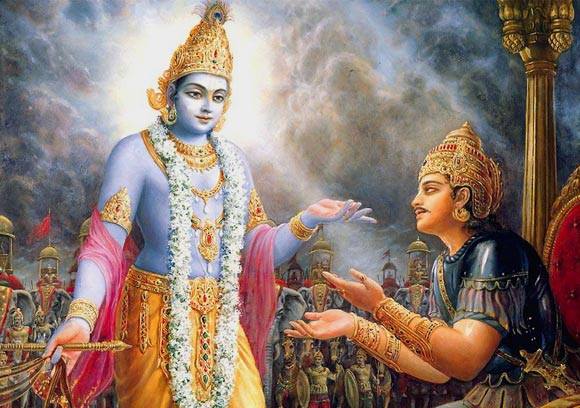Gita : Ch-8. Slo-2.
Srimad Bhagavad-Gita :
Chapter-8. ( Akshara-brhama-yogam )
Slokam-2. (How does this Lord of sacrifice live in the body, and in which part does He live, O Madhusudana? And how can those engaged in devotional service know You at the time of death?)
adhiyajnah katham kotra dehesmin madhusudana,
prayanakale ca katham jneyosi niyatatmabhih.
adhiyajnah kah katham = who is the Lord of yjnam and how acts;
ca = not only that;
prayanakale = at the time of death;
niyatatmabhih = the self controlled yogi-s;
katham jneyah asi = how ( the yogi-s ) know you Lord!
The Lord of sacrifice accepts Indra and Vishnu. Vishnu is the chief of the primal demigods, including Brahma and Siva, and Indra is the chief of the administrative demigods. Both Indra and Vishnu are worshiped by yajna performances. But here Arjuna asks who is actually the Lord of yajna (sacrifice), and how is the Lord residing within the body of the living entity.
Arjuna addresses the Lord as Madhusudana because Krishna once killed a demon named Madhu. Actually these questions, which are of the nature of doubts, should not have arisen in the mind of Arjuna because Arjuna is a Krishna conscious devotee. Therefore these doubts are like demons. Since Krishna is so expert in killing demons, Arjuna here addresses Him as Madhusudana so that Krishna might kill the demonic doubts that arise in Arjuna's mind.
Now the word prayana-kale in this slokam is very significant because whatever we do in life will be tested at the time of death. Arjuna fears that at the time of death, those who are in Krishna consciousness will forget the Supreme Lord because at such a time body functions are disrupted and the mind may be in a panic-stricken state. Therefore Maharaja Kulasekhara, a great devotee, prays, "My dear Lord, may I die immediately now that I'm healthy so that the swan of my mind may enter into the stem of Thy lotus feet." This metaphor is used because the swan often takes pleasure in entering the stem of the lotus flower—similarly, the mind of the pure devotee is drawn to the lotus feet of the Lord. Maharaja Kulasekhara fears that at the moment of death his throat will be so choked up that he will not be able to chant the holy names, so it is better to "die immediately." Arjuna questions how one's mind can remain fixed on Krishna's lotus feet at such times.
Arjuna further wants to know who is the adhiyagna or the Supreme Being in which to give propitiation and worship to? Who is the director of all actions and the ultimate bestower of the rewards of action in this propitiation that is constantly going on in the physical body. First he asked about the nature of adhiyagna, now he wants to know about the manner in which it operates within the physical body. As the indwelling monitor how does He preside over yagna or propitiation and worship. The word yagna implies all authorised Vedic rituals and worship. Finally Arjuna wants to know by what means is the Supreme Lord to be known and remembered at the moment of death to those of controlled minds and senses.
What is the tad brahma or the supreme,spiritual substratum pervading all existence? What is adhiyatma or the soul within all embodied beings? What is karma or the equal reaction to any action? How is it possible to effect moksa or liberation from the cycle of birth and death by knowing these things and taking shelter of Bhagavan or the possessor of full knowledge, full power, full fame, full wealth, full beauty and full renunciation, who is the Supreme Lord Krishna? What is the adhibhuta referring to embodied beings and adhidaivas referring to the demigods which the atharthis or seekers of wealth must know? What also is indicated by the term adhiyagna which all three classes of aspirants have to be cognisant of beings atharthis, jijnasurs or those desiring soul realisation and jnani's or those exclusively seeking the Supreme Lord and why is it specially characterised? Finally Arjuna wanted to know specifically in what way is the Supreme Lord Krishna to be realised by persons of controlled mind and senses at the time of death.
What is adhiyagna that is entitled for propitiation and to whom is this propitiation offered? Who is the specific god? Who is the receiver of this yagna or propitiation offered in worship? Is it Indra the chief of all the demigods or is it to the Supreme Lord? If the Supreme Lord is the receiver then is yagna offerred to Him internally residing inside the physical body or is it offered externally to His manifestation outside the physical body? If the yagna is offered internally then in what way does the Supreme Lord accept the offering? Finally it is asked how and in what way is the Supreme Lord Krishna to be realised at the time of death of the physical body? Arjuna addresses Lord Krishna in the vocative case using the anonym Madhusudana, the killer of the Madhu demon. The purport of this is that just as it is easy for Lord Krishna to terminate demons, it is also easy for Him to terminate the doubts in Arjuna's mind concerning these subjects.
To be continued ...





Comments
Post a Comment